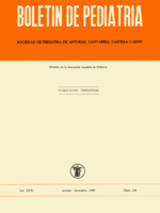Abstract
Human herpesvirus-6 (HHV-6) was first isolated in 1986 from lymphoproliferative disorders patients and patients with Immunodeficiency Virus infected. HHV·6 is distinct from known human herpesviruses, biologically, imrnunologically and by molecular analisis. The prevalence of HHV-6 antibody is elevated in sera from certain malignancies, Sjögren's syndrome and sarcoidosis. Most subjects are infected in early childhoold. Seroconversion ocurred between 1 and 3 years of age. Has been implicated as a causative agent of exantema subitum, a disease common in infants and children 6 months to 3 years, because was frequently isolated from peripheral blood mononuclear cells. Seroconversion against HHV-6 was also documented in these infants. The mode of transmission of HHV·6 is unclear, mother to child difussion is plausible.

This work is licensed under a Creative Commons Attribution-NonCommercial 4.0 International License.
Copyright (c) 1990 Boletín de Pediatría
